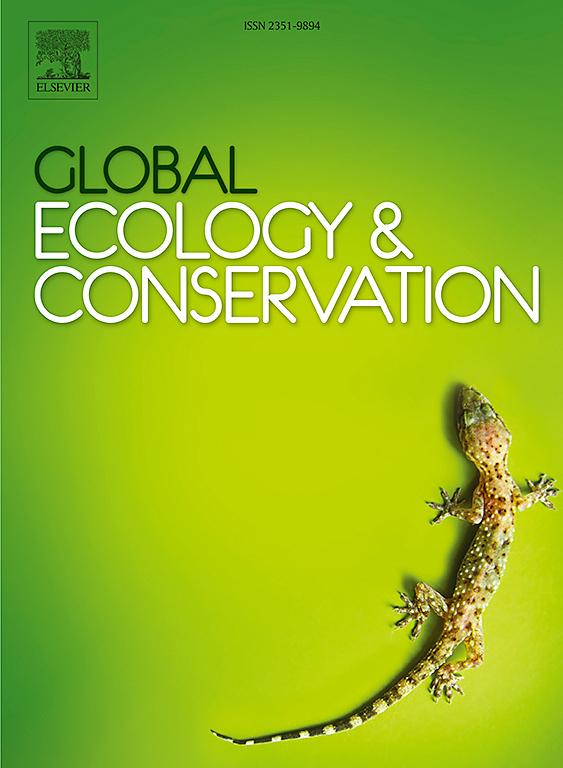Seasonal niche overlap and shifts: Implications for coexisting Larimichthys species in the East China Sea
IF 3.4
2区 环境科学与生态学
Q1 BIODIVERSITY CONSERVATION
引用次数: 0
Abstract
The large yellow croaker (Larimichthys crocea), a critically endangered marine fish of high economic value in China, suffered severe wild population declines in the 1980s due to overfishing and habitat degradation. Since 2000, habitat protection and large-scale restocking programs have sought to recover this ecologically important species. However, these efforts face ecological challenges, as L. crocea shares habitat and environmental preferences (temperature, salinity, depth) with its sister species, the small yellow croaker (Larimichthys polyactis), raising concerns about interspecific competition. This study quantified their climatic niche overlap using principal component analysis and generalized boosting models, integrating occurrence records and key environmental variables (temperature, salinity, depth, mixed layer thickness) across seasons. Results revealed significant niche overlap, with Schoener’s D values ranging from 0.55 (summer) to 0.66 (winter), indicating heightened competition risks during overwintering periods. L. polyactis exhibited broader niche breadth and greater salinity adaptability, whereas L. crocea displayed niche conservatism, relying on stable coastal habitats (40–70 m depths). Seasonal drivers differed: mixed layer thickness shaped summer distributions, while temperature and sea surface height dominated winter patterns. Overlap zones (4.73 % of the study area) concentrated in Zhejiang’s coastal waters, coinciding with key fishing grounds. Vertical stratification and dietary differences likely reduced direct competition, but L. crocea’s narrow niche breadth increases its vulnerability to environmental change. This study advocates for spatially explicit management, including decreased seasonal fishing effort in high-overlap zones and prioritizing restocking in non-overlapping areas. These findings advance understanding of niche-mediated coexistence in marine ecosystems and provide science-based strategies to balance species recovery with sustainable fisheries.
季节生态位重叠与转移:对东海共生Larimichthys物种的启示
大黄鱼(Larimichthys crocea)是中国一种极具经济价值的濒危海洋鱼类,由于过度捕捞和栖息地退化,在20世纪80年代遭受了严重的野生种群减少。自2000年以来,栖息地保护和大规模的重新放养计划试图恢复这种生态上重要的物种。然而,这些努力面临着生态挑战,因为crocea与其姊妹物种小黄鱼(Larimichthys polyactis)共享栖息地和环境偏好(温度,盐度,深度),引起了对种间竞争的担忧。本研究利用主成分分析和广义增强模型,结合不同季节的发生记录和关键环境变量(温度、盐度、深度、混合层厚度),量化了它们的气候生态位重叠。结果表明,生态位重叠显著,Schoener’s D值在0.55(夏季)~ 0.66(冬季)之间,表明越冬期竞争风险较高。L. polyactis表现出更宽的生态位宽度和更强的盐度适应性,而L. crocea表现出生态位保守性,依赖于稳定的沿海生境(40-70 m深度)。季节驱动因素不同:混合层厚度影响夏季分布,而温度和海面高度主导冬季分布。重叠区(4.73 %)集中在浙江沿海水域,与重点渔场重合。垂直分层和饮食差异可能减少了直接竞争,但水藻狭窄的生态位宽度增加了其对环境变化的脆弱性。本研究提倡空间明确管理,包括减少高重叠区域的季节性捕捞量,优先在非重叠区域重新放养。这些发现促进了对海洋生态系统中生态位介导共存的理解,并为平衡物种恢复与可持续渔业提供了基于科学的策略。
本文章由计算机程序翻译,如有差异,请以英文原文为准。
求助全文
约1分钟内获得全文
求助全文
来源期刊

Global Ecology and Conservation
Agricultural and Biological Sciences-Ecology, Evolution, Behavior and Systematics
CiteScore
8.10
自引率
5.00%
发文量
346
审稿时长
83 days
期刊介绍:
Global Ecology and Conservation is a peer-reviewed, open-access journal covering all sub-disciplines of ecological and conservation science: from theory to practice, from molecules to ecosystems, from regional to global. The fields covered include: organismal, population, community, and ecosystem ecology; physiological, evolutionary, and behavioral ecology; and conservation science.
 求助内容:
求助内容: 应助结果提醒方式:
应助结果提醒方式:


